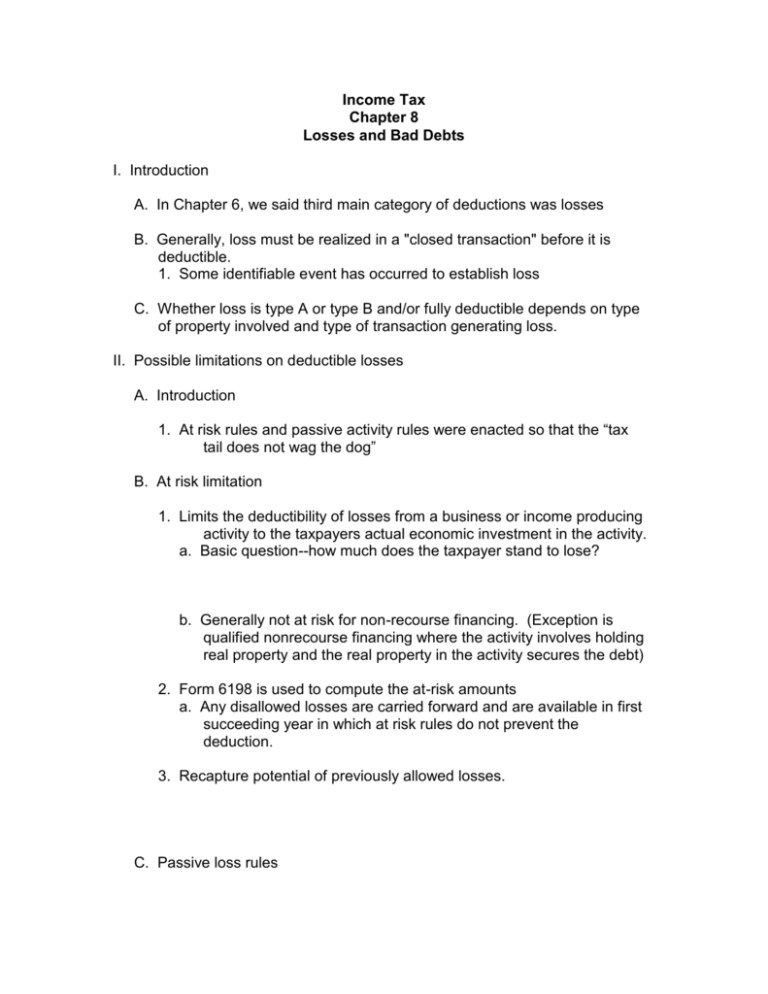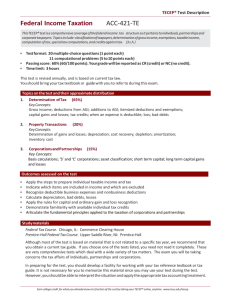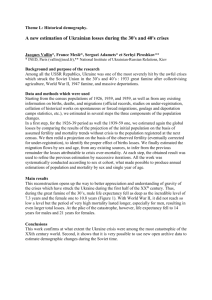Chapter 8
advertisement

Income Tax Chapter 8 Losses and Bad Debts I. Introduction A. In Chapter 6, we said third main category of deductions was losses B. Generally, loss must be realized in a "closed transaction" before it is deductible. 1. Some identifiable event has occurred to establish loss C. Whether loss is type A or type B and/or fully deductible depends on type of property involved and type of transaction generating loss. II. Possible limitations on deductible losses A. Introduction 1. At risk rules and passive activity rules were enacted so that the “tax tail does not wag the dog” B. At risk limitation 1. Limits the deductibility of losses from a business or income producing activity to the taxpayers actual economic investment in the activity. a. Basic question--how much does the taxpayer stand to lose? b. Generally not at risk for non-recourse financing. (Exception is qualified nonrecourse financing where the activity involves holding real property and the real property in the activity secures the debt) 2. Form 6198 is used to compute the at-risk amounts a. Any disallowed losses are carried forward and are available in first succeeding year in which at risk rules do not prevent the deduction. 3. Recapture potential of previously allowed losses. C. Passive loss rules 1. These rules are very complex and detailed--we are only going to be looking at the basics. 2. Three categories of income a. Active b. Portfolio c. Passive 3. Basically, passive losses (PAL’s) can only be offset against passive income (PIG’s) a. Rules apply to individuals, estates, trusts, closely held C Corporations and personal service corporations. 4. Concept of “Activity” and defining activities (See example 8-11 on page 8-10) 5. Concept of "Material Participation" a. Temporary regs provide seven specific tests for determination I. Does the individual participate in the activity for more than 500 hours during that year? ii. Does the individuals participation in the activity for the taxable year constitute substantially all of the participation in the activity of all individuals (including non-owner employees) for the year? iii. Does the individual participate in the activity for more than 100 hours during the year, and is the individuals participation not less than the participation of any other individual (including non-owner employees) for the year? iv. Is the activity a significant participation activity for the year (participation exceeds 100 hours) and the individuals aggregate participation in all significant participation activities during the year exceeds 500 hours. v. Did the individual materially participate in the activity for any five taxable years (not necessarily consecutive) during the ten taxable years that immediately precede the taxable year? vi. Is the activity a personal service activity, and did the individual materially participate in the activity for any three preceding taxable years (not necessarily consecutive) vii. Facts and circumstances test -- participate on a regular, continuous and substantial basis? 6. From a planning perspective a. Most beneficial if profitable activities are passive b. Most beneficial if loss activities are active 7. Rental activities a. Code specifies that rental activities are automatically treated as passive b. Certain rental situations are treated as nonrental activity i. See footnote 16 on page 8-9 for specifics ii. Must evaluate these activities under "material participation" test c. Rental real estate activities - special rules i. Rental real estate losses of "real estate professionals" are treated as active. ii. "Active participation" rental real estate activities a). Active participation -- participate in the making of management decisions in a significant and bona fide sense. b). Up to $25,000 of losses on rental real estate activities can be offset against other income sources. 1). This is phased out. Reduced by 50% of the taxpayer's AGI in excess of $100,000 (except for MFS who lose the rental loss deduction) D. Reporting of passive activities 1. Reported on Form 8582 2. All passive activities are combined to see whether you have a net gain or loss a. Exception for publicly traded partnership (PTP) - they stand alone 3. If result is a loss, then loss is suspended a. Remember $25,000 exception for active participation rental real estate b. If only part of losses are allowed, the allowed loss is allocated among loss activities proportionately -- see example 9 4. Suspended losses can be carried forward indefinitely a. Can be offset against future passive income b. Can be deducted if activity is fully disposed of in a taxable transaction i. Important factor to consider when you are identifying what constitutes an activity. III. Worthless debts and securities A. In General 1. Must be bona fide debtor/creditor relationship (a) Especially crucial between related parties 2. Must classify as business vs. non-business (a) Definition - non-business - unrelated to trade or business when made or when became worthless (b) Taxwise, distinction is important (1) Nonbusiness bad debt (2) Business bad debt B. Business Bad Debts 1. Must use specific write-off method (exception is certain financial institutions) 2. Cash basis taxpayer - naturally no deduction C. Loss on worthless securities 1. Must become worthless during the tax year 2. Deemed to have become worthless on last day of tax year 3. Loss generally treated as capital loss 4. Section 1244 Stock (a) Special rules must be met when stock is issued (b) Can claim ordinary loss of up to 50,000 (100,000 on a joint return) per year. (c) Applies whether stock is sold or worthless (d) Get Articles of Incorporation--generally it will disclose if stock was issued pursuant to Section 1244 D. Loss of deposit in insolvent financial institution 1. Generally treat as nonbusiness bad debt unless elect to treat as personal casualty loss. a. Treat as miscellaneous itemized deduction--loss limited to 20,000 per institution per year. IV. Casualty and theft losses A. Applicable to business, investment and personal use property, but different rules apply. B. What is casualty loss? 1. Complete or partial destruction of property resulting from an event due to some SUDDEN, UNEXPECTED OR UNUSUAL CAUSES. C. Measure of loss 1. Lesser of 1) Decline in FMV or 2) Adjusted basis of property (a) Exception for business losses where property completely destroyed. (1) Loss is always equal to adjusted basis of property 2. Sometimes the cost to repair the property might be used as the measure of the loss. 3. Loss is always reduced by any insurance recoveries. (May result in gains) D. When is loss deductible? 1. Generally in year loss or casualty occurs. Theft losses in the year of discovery. 2. Exception is when reasonable claim for full insurance recovery exists at year-end 3. Disaster area declared by President--can deduct preceding year E. How are losses treated on return 1. Business losses - deducts for AGI 2. Personal losses (a) Reduce loss for each casualty by $100 floor (b) Net gains and losses against each other (c) Rules If gains are greater than losses, then all gains equal capital gains, all losses equal capital losses. Short term or long term depending on length of time held. If losses are greater than gains, then all gains and losses are ordinary. The losses in excess of gains are subject to the 10% of AGI floor. V. Net Operating Losses (N.O.L) A. Provision set up due to inequities which may arise due to annual accounting period concept. B. Intended as relief provision when business losses exceed business income. 1. Only "personal" deduct which contributes to an N.O.L. is a personal casualty loss. 2. Hence taxable "loss" shown on return is not N.O.L. amount. C. Computation of Net Operating Loss (N.O.L.) 1. Start with taxable income as shown on return (a) Note lines 1-3 on Form 1045 computes taxable income 2. Make adjustments to taxable income as follows (a) Add back N.O.L.'s from other years. (b) Add back personal and dependency exemptions (c) Add any capital losses deducted on return (d) Adjust for non-business deducts in excess of non-business income. (1) See copy of Pub 536 for examples of nonbusiness income and deductions. (2) Non-business capital gains in excess of non-business capital losses are included in non-business income total for comparing to non-business deductions. 3. For NOL’s arising in tax years beginning after August 5, 1997, the carry back period is two years and the carry forward period is twenty years. (a) N.O.L's previously were carried back 3 years and forward 15 until used up. (b) Maintain the three year carry back rule for portion of the loss resulting from a casualty or theft loss, and for losses in Presidentially declared disaster areas incurred by a small business or a farmer. (c) Can elect to carry forward only (1) Must be elected on return which is filed that has N.O.L. (2) Election depends on marginal tax rates in prior vs future years. Tax credits freed up which may not be able to be utilized, etc. 4. Please note that we have only discussed one of 3 possible calculations that may possibly have to be made. (a) Calculate the N.O.L. using the current year's income tax return (b) Recalculate taxable income for the year to which the N.O.L. is carried to. (1) Treat N.O.L. as a type A deduction (2) Do not recalculate charitable contribution limitations. (c) Calculate any N.O.L. carryover using the carry back year's return. e.g. Did you use the entire loss up in carry back year? (1) Compute taxable income with certain modifications.








